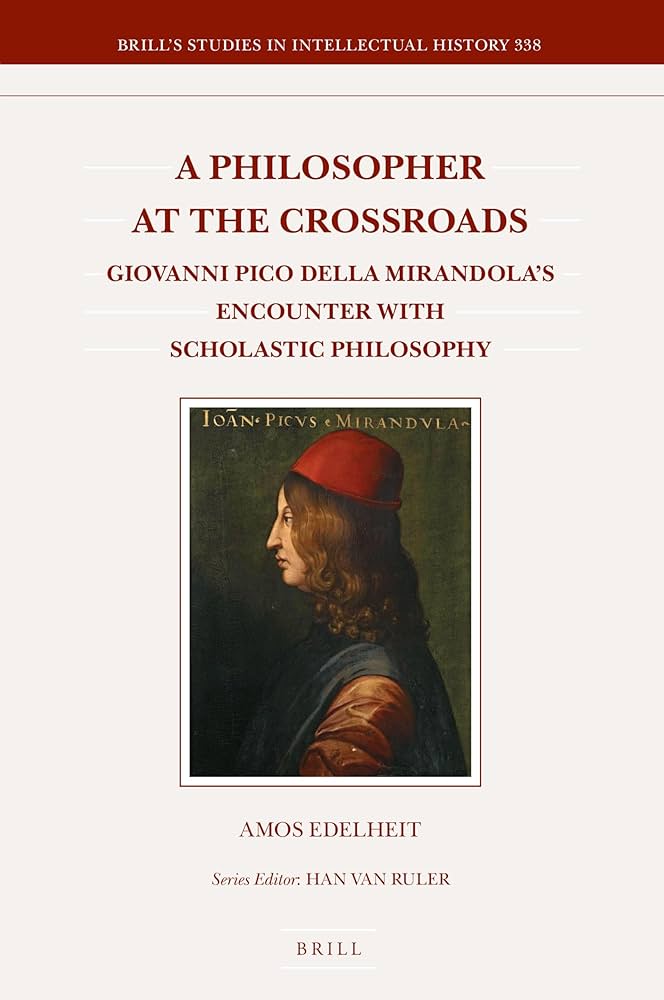Giovanni Pico and the Scholastics: A Note on «A Philosopher at the Crossroads»
Contenido principal del artículo
Resumen
This review note surveys some important aspects of a recent publication by Amos Edelheit, A Philosopher at the Crossroads: Giovanni Pico della Mirandola’s Encounter with Scholastic Philosophy. While focus over the last decades has been placed on Pico’s thought in relation to Jewish Kabbalah and mysticism, Edelheit hopes to emphasize the importance of the scholastic tradition (or, rather, the pluriform and various tradition of late medieval and Renaissance scholasticism) in Pico’s thought, and the ways in which this intellectual context places this unique Renaissance thinker at a sort of ‘crossroads’. Beyond providing a brief overview of the three main parts of the text, this note examines more closely Edelheit’s study of Pico’s 900 Theses and the methodological approach which involves a reconstruction of the dialectical context for each thesis. The Latin scholastics are real conversational partners for Pico: he is versed in the 13th-century scholastic sources, is certainly familiar with contemporaneous scholastic thought, and is able to employ scholastic methods and terminology within his wider philosophical project. While scholastic philosophy was very much alive at the end of the fifteenth century, Pico’s new and inclusive approach to philosophy and the history of philosophy, never eschewing the Latin masters, departs from both scholastic and humanist trends.
Descargas
Detalles del artículo

Esta obra está bajo una licencia internacional Creative Commons Atribución 4.0.
Política propuesta para las revistas que ofrecen acceso abierto
Los autores que publican en esta revista aceptan las siguientes condiciones:
a. Desde el número IV y para los números futuros, la política de la editorial es que los autores conserven los derechos de autor y concedan a la revista el derecho de primera publicación con el trabajo licenciado simultáneamente bajo una Licencia de Atribución Creative Commons que permita a otros compartir el trabajo con un reconocimiento de la autoría del trabajo y la publicación inicial en esta revista.
b. Los autores pueden establecer acuerdos contractuales adicionales para la distribución no exclusiva de la versión publicada del trabajo en la revista (por ejemplo, enviarlo a un repositorio institucional o publicarlo en un libro), con un reconocimiento de su publicación inicial en esta revista.
c. Se permite y anima a los autores a publicar su trabajo en línea (por ejemplo, en repositorios institucionales o en su sitio web) antes y durante el proceso de presentación, ya que puede dar lugar a intercambios productivos, así como a una citación más temprana y mayor del trabajo publicado (Véase The Effect of Open Access).
Citas
Gianfrancesco Pico della Mirandola & Giovanni Pico della Mirandola, Life of Giovanni Pico della Mirandola, Oration, ed. and trans. Brian Copenhaver, Harvard University Press, Cambridge MA–London 2022 (I Tatti Renaissance Library, 93).
* * *
Burzelli, Luca, « Specters of Pico: A Note Concerning a Recent Book on the Oratio de dignitate hominis », Mediterranea: International Journal on the Transfer of Knowledge, 7 (2022), p. 391–422.
Caroti, Stefano, « Note sulle fonti medievali di Pico della Mirandola », Giornale critico della filosofia italiana 84 (2005), p. 60–92.
Copenhaver, Brian P., Magic and the Dignity of Man: Pico della Mirandola and His Oration in Modern Memory, Belknap–Harvard University Press, Cambridge MA–London 2019.
— Pico della Mirandola on Trial: Heresy, Freedom, and Philosophy, Oxford, Oxford 2022.
Edelheit, Amos, A Philosopher at the Crossroads: Giovanni Pico della Mirandola’s Encounter with Scholastic Philosophy, Brill, Leiden–Boston 2022 (Brill’s Studies in Intellectual History, 338).
Engel, Michael, Elijah Del Medigo and Paduan Aristotelianism: Investigating the Human Intellect, Bloomsbury, London 2017.
Farmer, S. A., Syncretism in the West: Pico’s 900 Theses (1486): The Evolution of Traditional Religious and Philosophical Systems, Medieval & Renaissance Texts & Studies, Tempe, 1998.
Kibre, Pearl, The Library of Pico della Mirandola, Columbia University Press, New York, 1936
Rousse-Lacordaire, Jérôme, Une controverse sur la magie et la kabbale à la Renaissance, Droz, Genève 2010.
Schmitt, Charles, Aristotle and the Renaissance, Harvard University Press, Cambridge, MA 1983.
Terracciano, Pasquale, Omnia in Figura: L’impronta di Origene tra ‘400 e ‘500, Edizioni di Storia e Letteratura, Roma 2012.
Toussaint, Stéphane, « Il Cristo di Pico: Dalla Croce al Trigramma », in Cristo nella filosofia moderna, a cura di Antonella Del Prete, Saverio Ricci, Le Lettere, Firenze 2014, p. 77–96
